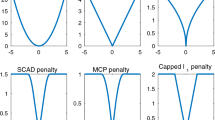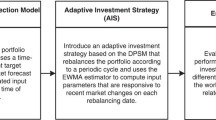Abstract
This paper investigates a continuous-time portfolio optimization problem with the following features: (i) a no-short selling constraint; (ii) a leverage constraint, that is, an upper limit for the sum of portfolio weights; and (iii) a performance criterion based on the lower mean square error between the investor’s wealth and a predetermined target wealth level. Since the target level is defined by a deterministic function independent of market indices, it corresponds to the criterion of absolute return funds. The model is formulated using the stochastic control framework with explicit boundary conditions. The corresponding Hamilton–Jacobi–Bellman equation is solved numerically using the kernel-based collocation method. However, a straightforward implementation does not offer a stable and acceptable investment strategy; thus, some techniques to address this shortcoming are proposed. By applying the proposed methodology, two numerical results are obtained: one uses artificial data, and the other uses empirical data from Japanese organizations. There are two implications from the first result: how to stabilize the numerical solution, and a technique to circumvent the plummeting achievement rate close to the terminal time. The second result implies that leverage is inevitable to achieve the target level in the setting discussed in this paper.













Similar content being viewed by others
Notes
The computer we use has the following specifications: Intel Core i9-X10900X, 3.5Hz, 12Cores, and 32GB RAM.
We see the histogram of \(E^{(i)}_t\).
Thus, the boundary point is given by \(x^* = (1+\bar{r}T)x_0\).
References
Cong, F., & Oosterlee, C. W. (2017). On robust multi-period pre-commitment and time-consistent mean-variance portfolio optimization. International Journal of Theoretical and Applied Finance, 20(7), 1–26.
De Franco, C., Nicolle, J., & Pham, H. (2019). Bayesian learning for the Markowitz portfolio selection problem. International Journal of Theoretical and Applied Finance, 22(07), 1950037.
Elie, R., & Touzi, N. (2008). Optimal lifetime consumption and investment under a drawdown constraint. Finance and Stochastics, 12(3), 299–330.
Fishburn, P. C. (1977). Mean-risk analysis with risk associated with below-target returns. The American Economic Review, 67(2), 116–126.
Forsyth, P. A., & Vetzal, K. R. (2017). Robust asset allocation for long-term target-based investing. International Journal of Theoretical and Applied Finance, 20(03), 1750017.
Gao, J., Zhou, K., Li, D., & Cao, X. (2017). Dynamic mean-LPM and mean-CVaR Portfolio optimization in continuous-time. SIAM Journal on Control and Optimization, 55(3), 1377–1397.
Hardy, R. (1990). Theory and applications of the multiquadric-biharmonic method 20 years of discovery 1968–1988. Computers and Mathematics with Applications, 19(8–9), 163–208.
Hata, H., & Sekine, J. (2017). Risk-sensitive asset management in a Wishart-autoregressive factor model with jumps. Asia-Pacific Financial Markets, 24(3), 221–252.
Huang, D., Zhu, S. S., Fabozzi, F. J., & Fukushima, M. (2008). Portfolio selection with uncertain exit time: a robust CVaR approach. Journal of Economic Dynamics and Control, 32(2), 594–623.
Ieda, M., Yamashita, T., & Nakano, Y. (2013). A liability tracking approach to long term management of pension funds. Journal of Mathematical Finance, 03(03), 392–400.
Ieda, M., Yamashita, T., & Nakano, Y. (2015). A liability tracking portfolio for pension fund management. Proceedings of the ISCIE International Symposium on Stochastic Systems Theory and Its Applications, 2015, 112–117.
Ismail, A., & Pham, H. (2019). Robust Markowitz mean-variance portfolio selection under ambiguous covariance matrix. Mathematical Finance, 29(1), 174–207.
Kansa, E. J. (1990). Multiquadrics-a scattered data approximation scheme with applications to computational fluid-dynamics-II solutions to parabolic, hyperbolic and elliptic partial differential equations. Computers and Mathematics with Applications, 19(8–9), 147–161.
Konno, H., Waki, H., & Yuuki, A. (2002). Portfolio optimization under lower partial risk measures. Asia-Pacific Financial Markets, 9(2), 127–140.
Li, X., Zhou, X. Y., & Lim, A. E. B. (2002). Dynamic mean-variance portfolio selection with no-shorting constraints. SIAM Journal on Control and Optimization, 40(5), 1540–1555.
Ma, G., & Zhu, S. P. (2019). Optimal investment and consumption under a continuous-time cointegration model with exponential utility. Quantitative Finance, 19(7), 1135–1149.
Ma, G., Zhu, S.-P., & Kang, B. (2020). A numerical solution of optimal portfolio selection problem with general utility functions. Computational Economics, 55(3), 957–981.
Merton, R. C. (1969). Lifetime portfolio selection under uncertainty: the continuous-time case. The Review of Economics and Statistics, 51(3), 247.
Miller, C. W., & Yang, I. (2017). Optimal control of conditional value-at-risk in continuous time. SIAM Journal on Control and Optimization, 55(2), 856–884.
Nakano, Y. (2017). Convergence of meshfree collocation methods for fully nonlinear parabolic equations. Numerische Mathematik, 136(3), 703–723.
Pham, H. (2009). Continuous-time Stochastic Control and Optimization with Financial Applications. In Stochastic modelling and applied probability, vol. 61. Springer
Stellato, B., Banjac, G., Goulart, P., Bemporad, A., & Boyd, S. (2020). OSQP: an operator splitting solver for quadratic programs. Mathematical Programming Computation, 12(4), 637–672.
Sundaresan, S. M. (2000). Continuous-time methods in finance: A review and an assessment. The Journal of Finance, 55(4), 1569–1622.
Wang, J., & Forsyth, P. A. (2010). Numerical solution of the Hamilton–Jacobi–Bellman formulation for continuous time mean variance asset allocation. Journal of Economic Dynamics and Control, 34(2), 207–230.
Wang, J., & Forsyth, P. A. (2012). Comparison of mean variance like strategies for optimal asset allocation problems. International Journal of Theoretical and Applied Finance, 15(02), 1250014.
Wendland, H. (2004). Scattered data approximation. Cambridge: Cambridge University Press.
Xidonas, P., Steuer, R., & Hassapis, C. (2020). Robust portfolio optimization: A categorized bibliographic review. Annals of Operations Research, 292(1), 533–552.
Acknowledgements
The author is grateful to the anonymous referees for their valuable comments on the first version of this paper. This work is supported by JSPS Grant-in-Aid for Young Scientists(Start-up) Grant Number JP20K22130.
Author information
Authors and Affiliations
Corresponding author
Additional information
Publisher’s note
Springer Nature remains neutral with regard to jurisdictional claims in published maps and institutional affiliations.
Rights and permissions
About this article
Cite this article
Ieda, M. Continuous-Time Portfolio Optimization for Absolute Return Funds. Asia-Pac Financ Markets 29, 675–696 (2022). https://doi.org/10.1007/s10690-022-09365-9
Accepted:
Published:
Issue Date:
DOI: https://doi.org/10.1007/s10690-022-09365-9




